The Date of the Exodus: 1446 BCPharaoh who killed Hebrew children: Amuntotep I: 1532-1511 BCPharaoh's Daughter who adopted Moses: Hatshepsut: 1526 BC
Pharaoh of Moses' flight to Midian: Thutmoses II/Hatshepsut: 1498-1485 BCPharaoh of the Exodus: Thutmoses III: 1485/1464 - 1431 BC
Pharaoh of Moses' flight to Midian: Thutmoses II/Hatshepsut: 1498-1485 BCPharaoh of the Exodus: Thutmoses III: 1485/1464 - 1431 BC
Thutmoses III was Pharaoh in 1446 BC for a total of 54 years. (1485-1431). But there were three distinct phases to his rule.
Thutmoses III: (1485-1431)
|
Introduction:
- The date of the exodus was 1446 BC when Israel left Egypt and 1406 BC when they crossed the Jordan into the promised land.
- The Bible is consistent and clear on this date: 1 Kings 6:1; Judges 11:26; Acts 13:19. The three verses are powerful, convincing and consistent.
- When Moses killed the Egyptian, he fled to Midian for 40 years from Thutmoses II who was Pharaoh from 1498-1485 BC.
- Thutmoses III was the Pharaoh of the Exodus who reigned 1485 - 1431 BC in three phases. The exodus occurred in Thutmoses III's 18 year of rule after his mother died.
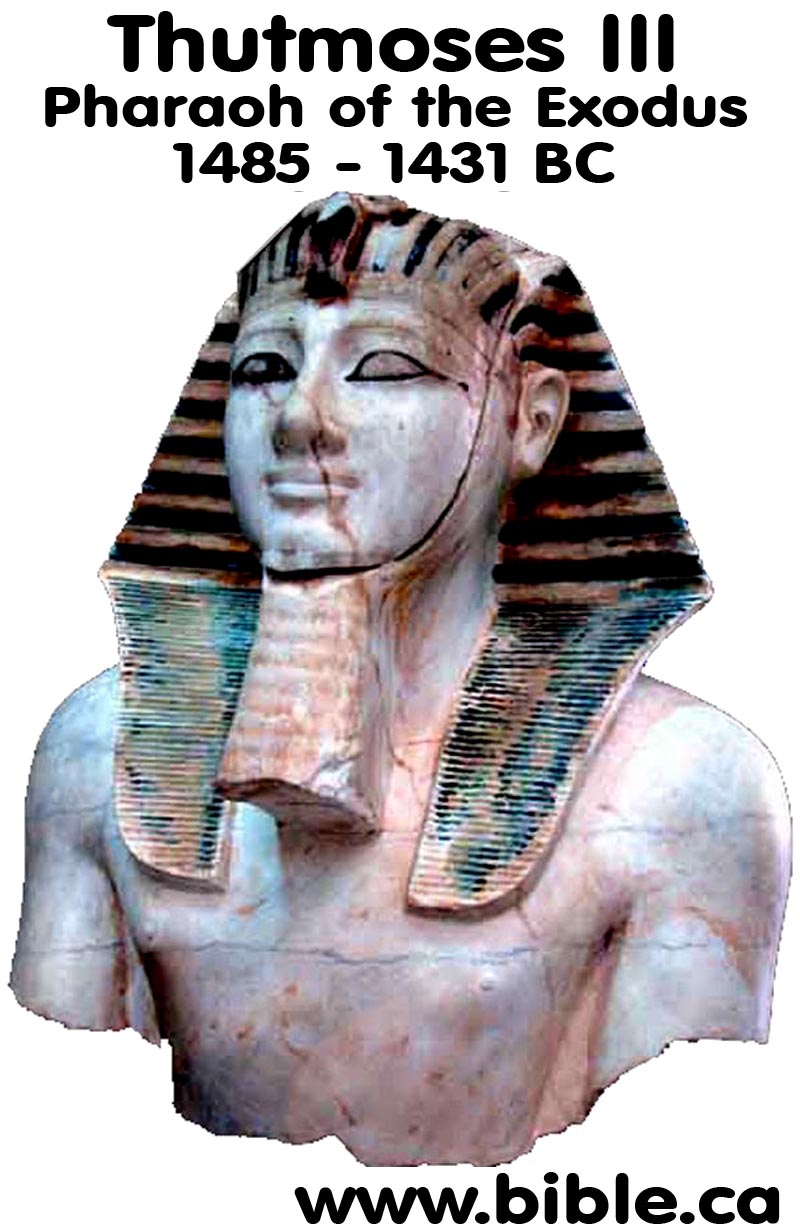
- The date of 1270 BC where Ramesses II was the Pharaoh is not accepted by Bible scholars, only Bible trashing archeologists who reject the Bible as true and accurate history.
- Archeologists who trash the historical reliability of the Bible refuse to recognize 1406 BC as the date Israel entered the promised land. When they excavate at Timna or Jericho, for example, and find stuff that is from 1406 BC they use it as proof that the Bible cannot be trusted. So they reject the Bible's date for the exodus of 1406 BC and claim it is 1270 BC. Then when they find archeological evidence from 1406 BC they say it proves the Bible wrong. When we remind them that the date of the Exodus revealed in the Bible of 1406 BC matches the archeological evidence they become silent. It is important to always keep in mind that secular historical sources bend over backwards to ensure there is no apparent presence of any kind of the Hebrews in Egypt. Many major reference books totally ignore any possible connection with Moses.
- There is only one argument from the Bible, an invalid one at that, which is used to support the false notion that Ramesses II was the Pharaoh of the exodus. Advocates of a 1270 BC exodus point out that Israel lived in the city of Ramesses and helped build it. They say, "Obviously the city did not proceed the Pharaoh whom it was named after. Sounds convincing until you read the passage that says Joseph lived in "the land of Ramesses" (Genesis 47:11). This proves that the land of Ramesses existed 430 years before Pharaoh Ramesses II was born! But it gets worse. Exodus 1:11 says that when Israel had to make mud bricks with straw, that "they built for Pharaoh storage cities, Pithom and Raamses." Remember that the 4 hour "Ten Commandments movie" we have all seen a hundred times has many errors, one of them being that the Pharaoh from whom Moses fled from to Midian, is the same Pharaoh to whom Moses said 40 years later, "Let my people go!" In fact they were two different Pharaohs! "Now it came about in the course ofthose many days that the king of Egypt died. And the sons of Israel sighed because of the bondage, and they cried out; and their cry for help because oftheir bondage rose up to God." Exodus 2:23; 4:19. This makes it impossible then, for the city of Ramesses to be named after Pharaoh Ramesses II. The final nail in the coffin of this vacuous argument is the fact that the city and the Pharaoh were spelled differently. The city is spelled Raamses, whereas the Pharaoh was spelled Ramesses or Ramesses. Ramesses means "begotten of Ra". Ra is the Egyptian sun god of the Hyksos. With such a central and common meaning to Egyptian religion, it is not hard to see how Ramesses II was named after the sun god, but with a different spelling. But those who make such arguments are not really interested in what the Bible says because they don't believe it in the first place. After all, if they read 1 Kings 6:1 and still hold to a 1270 BC Exodus date why would the fact that the city of Ramesses existed almost 500 years before Pharaoh Ramesses II?
- We have reviewed all the reasons why some reject the Bible's 1446 BC date of the exodus in favor of 1270 BC and have dismissed them as being vacuous and without merit. The bulk of the reasons given involve nothing more than, "We haven't found archeological evidence of such and such". Evidence may or may not ever be found but we are reminded of the recent discover of evidence of the Hittite nation. At the turn of the century, skeptics viewed the Bible as myth rather than real world history . For example, the Bible makes over 40 references to the great Hittite Empire. You see, 100 years ago, no archaeological evidence had ever been found to prove it really did exist. "Just another Bible myth!" skeptics charged in an attempt to destroy our faith in the Bible. This, however, cannot be said today, for in 1906, Hugo Winckler uncovered a library of 10,000 clay tablets. These ancient records fully documented the long lost Hittite Empire and confirmed the reliability of the Bible. Later excavations uncovered Boghazkoy, the capital city of this "mythical" empire.
- Summary of dates revealed in the Bible:
- Leaving Egypt to 4th year of Solomon's reign is 480 years: 1 Kings 6:1 (Solomon reigned in 960 BC)
- Crossing the Jordan to Jephthah is 300 years Judges 11:26 (Jephthah lived in 1100 BC)
- Enter Egypt to the time of Samuel was 450 years: Acts 13:19 (400 + 40 + 10: Joshua took 10 years to take the land)
- The period of the Judges is 262 years. (From death of Joshua in 1356 BC to birth of Samuel in 1094 BC)
- The many genealogies of the Bible verify and confirm everything.
- Summary of dates from history and archeology:
- Imitation Cypriot pottery discovered at Jericho proves the walls fell about 1406 BC.
- The conversion of Akhenaten to monotheism after Israel crossed the Jordan is a significant marker in the sand verified by the Amarna Tablets. (1358-1341 BC)
- The Amarna Tablets which chronicle the conquest of Joshua in the promised land in 1406 BC
- The Merneptah Stele written (1205 BC) at the time of Deborah (Judges 4, 1204-1144 BC) and shows Israel an established nation effectively refuting the notion that Ramesses II is the pharaoh of the exodus.
- Trust the Bible when it dates the exodus to 1446 BC. Reject 1270 BC for the date of the exodus.
- The New Egyptian Chronology: Our chronology chose Thutmoses III as the Pharaoh of the Exodus because an incredible double marker stands out like a flashing neon light in Thutmoses III's life. Two key events happened at the same time:
The New Chronology of the Pharaohs of Egypt(by Steve Rudd)
This low Egyptian chronology is derived, in part in part with the Ebers Papyrus, by assuming that the heliacal rising of Sothis was observed from the city of Thebes (Theban) which produces a date of 1523 BC (+/- 6 yrs) and therefore sets the reign of Amenhotep I to 1531-1511 BC.
We follow K. A. Kitchen in using the low chronology and add six years to all his dates.
| |||
Pharaoh
|
Reign
|
Dates
|
notes
|
Ahmose (Nebpehtyre)
|
25
|
1557-1532
|
Hyksos defeated, rise of the pharaoh who knew not Joseph. Hatshepsut born 1536 to Thutmoses I
|
Amuntotep I (Djeserkare)
Kills Hebrew children in 1526 |
21
|
1532-1511
|
Moses born and Hebrew children killed in 1526. Princess Hatshepsut age 10, finds Moses
|
Thutmoses I (Aakheperkare)
|
13
|
1511-1498
| |
Thutmoses II (Aakheperenre)
Pharaoh of oppression in 1488 Married to step-sister Hatshepsut |
13
|
1498-1485
|
Oppression, Moses flees the year before his adopted mother begins to co-reign with Thutmoses III, when Thutmoses II died. Thutmoses III born around 1496 when Moses was 30. Moses 40 in 1486
|
Hatshepsut, and infant son Thutmoses III co rule for 20 years
|
21
|
1485-1464
|
Hatshepsut died in 1464 at age 77
|
Thutmoses III ruler before exodus
|
18
|
1464-1446
|
17 annual campaigns came to an end in 1446 never happened because the army drowned in the Red Sea
|
18th year of Thutmoses III is exactly 480 yrs before Solomon builds temple
|
Year
18 |
Exodus
1446 |
1 Kings 6:1
|
Thutmoses III after exodus
|
15
|
1446-1431
|
No campaigns after Exodus
|
Amenhotep II (Aakheperure)
(second born son)
|
25
|
1431-1406
|
Weak king who signs peace accords. Israel has been at Kadesh for 12 years when he becomes king and dies the year Joshua crossed the Jordan.
|
Thutmoses IV (Menkheperure)
|
10
|
1406-1396
|
.
|
Amunhotep III (Nebmaatre)
|
38
|
1396-1358
|
.
|
Akhenaten (Amunhotep IV)
|
17
|
1358-1341
|
Become King 1 year before Joshua dies. Converts to monotheism.
|
Tutankhamun (Nebkheperure)
|
10
|
1341-1331
|
Reverts to polytheism and is murdered.
|
Ay (Kheperkheperure)
|
3
|
1331-1328
|
.
|
Horemheb (Djeserkheperure)
|
28
|
1328-1300
|
.
|
Totals
|
257
|
1557-1300
|
.
|
B. 17 reasons why Thutmoses III is the Exodus Pharaoh:
- "Moses" derives his name from Thutmoses I and the "Thutmoses" dynasty of kings. Thutmoses I was the father of Hatshepsut who named Moses. This is obviously where Moses got his name, not from the 19th dynasty era of Rameses II. Because archeologists generally dismiss the exodus as a Bible myth, they actually chose any variant of the correct, "Thutmoses" that breaks any connection with "Moses". These variant spellings include: Tuthmosis, Thuthmose, Thutmose. Remember that the name "Thutmoses" was written in hieroglyphics (pictures), but the name Moses is written in Hebrew and Greek. Because we are certain of how Moses' name was spelled in English, and because we know he got his name from the Hatshepsut. the daughter of Thutmoses I, the modern archeological world, and all Bible students would be both prudent and correct to begin spelling the 18th dynasty pharaohs as "Thutmoses". This is a case of using the inspired text of the Bible to teach us how to correctly spell the Thutmoses dynasty of kings of Egypt!
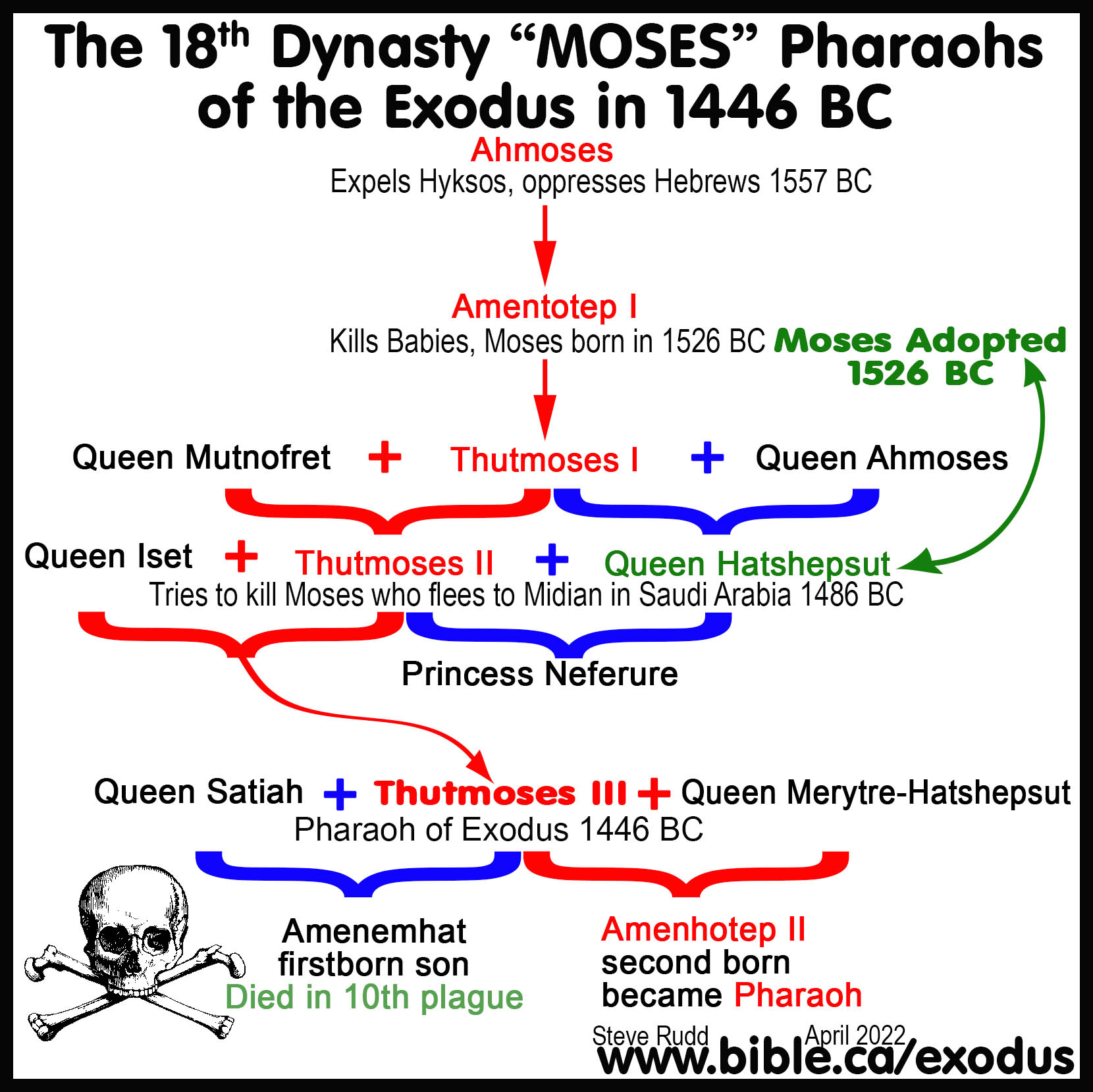
- Hatshepsut is "Pharaoh's daughter" who adopted Moses:
Hatshepsut, is the only candidate for the "Pharaoh's daughter" who drew Moses out of the Nile. Born in 1541 BC, she would have been 15 when Moses was born in 1526. Hatshepsut's father was Thutmoses I and her mother was Queen Amoses. Queen Ahmose had four children with Thutmosis I, but three died young leaving Hatshepsut as the only person who could wear the title of "Pharaoh's daughter". (Ex 2:7-10; Acts 7:21; Heb 11:24) The bible says that pharaoh's daughter adopted Moses out of pity. However, since she was unable to ever bear a son to Thutmoses II, Moses became her only chance for personal succession. This all changed when Moses was about 30, when Thutmoses II's second wife named Iset, bore him a son named Thutmoses III. Remember that Thutmoses II was Hatshepsut's step-brother whom she married jointly and raised Moses to adulthood. Moses was heir apparent, until Thutmoses III was born when Moses was 30 in 1496 BC.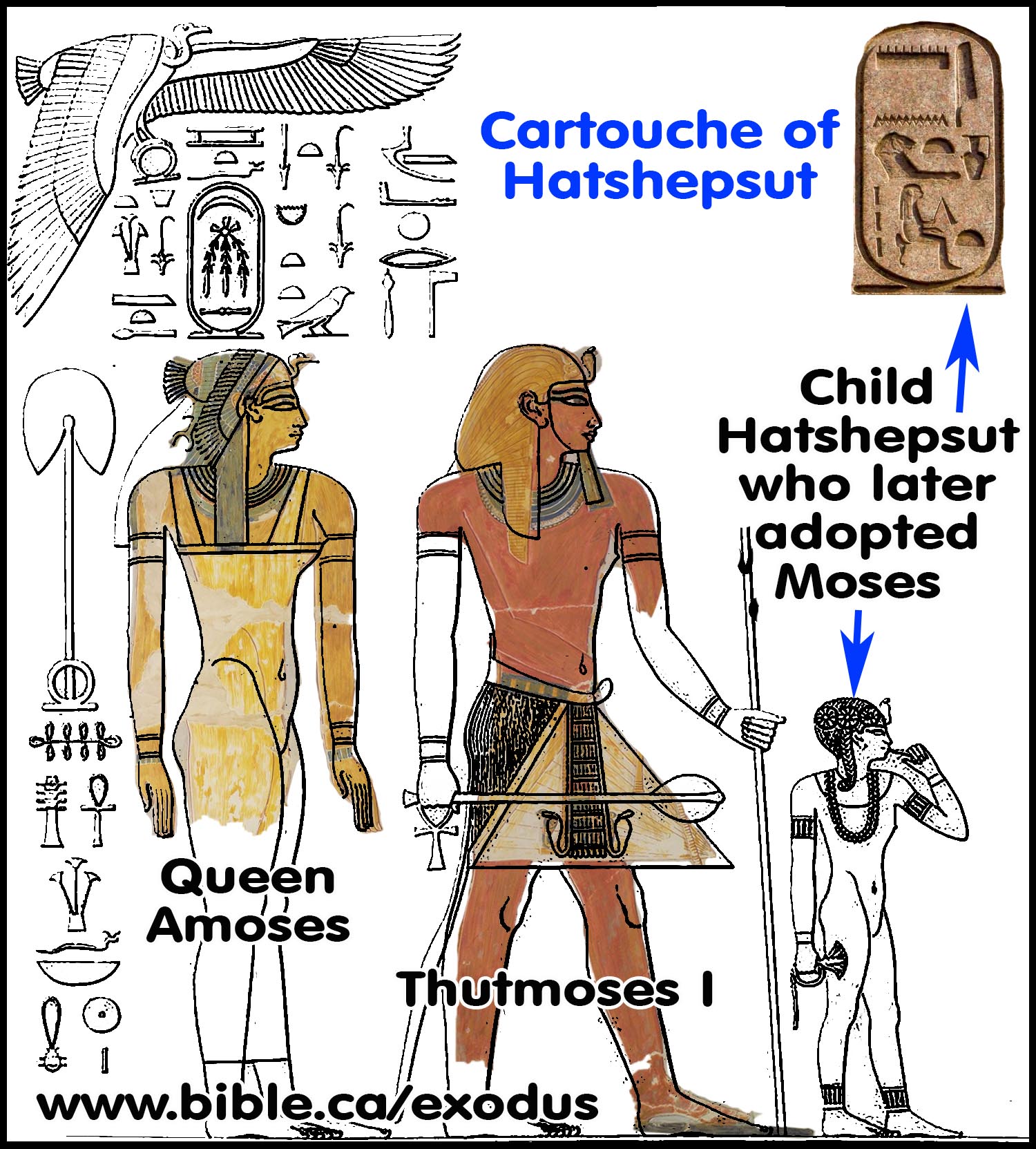
- Thutmoses III was Pharaoh in 1446 BC: (1485-1431)
Thutmoses III was Pharaoh in 1446 BC for a total of 54 years. (1485-1431). There were three distinct phases to his rule.
First: (1495-1464) was when he was a baby and his step-mother Hatshepsut ruled as co-regent for 21 years. This period is generally ascribed directly to Hatshepsut as Pharaoh, especially since she proclaimed herself pharaoh before she died. Thutmoses III was Hatshepsut step son and when her husband and step brother Thutmoses II died, she ruled until Thutmoses III grew up.
Second: (1464-1446) after Hatshepsut died Thutmoses III ruled as Pharaoh for 18 years until the exodus.
Third: (1446-1431) Thutmoses III ruled another 15 years after the exodus.
Ramesses II is wrongly believed to be the pharaoh of the exodus in 1270 BC on the basis of a single piece of information: "So they appointed taskmasters over them to afflict them with hard labor. And they built for Pharaoh (of the oppression) storage cities, Pithom and Raamses." Exodus 1:11 The argument is as simplistic as it is wrong and goes like this: The Hebrews built the city of Raamses, therefore the pharaoh of the exodus must be a guy named "Ramesses II". It escapes their notice that Joseph lived in the "land of Rameses" 400 years before Ramesses II was born: "So Joseph settled his father and his brothers and gave them a possession in the land of Egypt, in the best of the land, in the land of Rameses, as Pharaoh had ordered." Genesis 47:11. This means that the name Rameses predated Ramesses II by 400 years! The only other reason why 1270 BC is chosen as the date of the exodus, is because Bible trashing archeologists make active attempts at destroying any possible connection between archeology and Bible history! Christians need a wake up call! - Thutmoses III was great, powerful and prideful!
Thutmoses III was one of the greatest and most powerful Pharaohs of Egypt. He is in the class of Herod the Great in 30 BC and Hadrian in 135 AD. His son, Amenhotep II, was small, insignificant and unaccomplished in contrast. The 17 campaigns of Thutmoses III into the promised land and surrounding areas (Levant), for example, are numbered successively throughout his reign. His 17 campaigns started in the second year and then one campaign each year for the next 17 years, then they ended in 1446! This means that his last campaign ended in year 18 or 19 after Hatshepsut died which is exactly the date of the exodus! Amenhotep II, his second born who succeeded him, had only two campaigns, in contrast to Thutmoses III seventeen. When you are looking for a powerful prideful Pharaoh that God wanted to display his power over, Thutmoses III is the man. Amenhotep II is a poor choice because he was an irrelevant vapour in contrast! Amenhotep II signed peace treaties with Mitanni in year 9 of his reign (1422 BC). This was as large a contrast with his father, as it would be for Obama Barack to sign as peace treaty with Iran without getting anything in return. (Hey wait! Obama actually did that!) For God to topple Amenhotep II was no great demonstration of his power since he was already seen as a weak Pharaoh whose boastful words did not match his actions. The boastful words of Thutmoses III matched his actions and everyone greatly feared him! Thutmoses III did not sign peace treaties with the Mitanni, he conquered them and unilaterally dictated his conditions to them! - The Hyksos knew Joseph but the 18th dynasty "did not know Joseph":
The timing of the expulsion of the Hyksos and the enslaving of Israel perfectly fits the Thutmoses III. The Hyksos ruled Egypt for 100 years from 1656-1556 BC. They were the "shepherd kings" that were friendly to the Hebrews. One might infer that they were a Semitic tribe like the Edomites. The book of Job shows Job to be the king of Edom or a preeminent patriarch, at about the time that Joseph enters Egypt. The Hyksos ruled Egypt for about 100 years and were friendly to the Hebrews, because they were fellow Semites who shared a common heritage through Abraham. When the Hyksos were defeated, a New Kingdom 18th dynasty of pharaoh's arose who "knew not Joseph". This would explain why the Hebrews were enslaved by the 18th dynasty pharaohs because the Hebrews were related to the Hyksos as fellow Semites. The slavery of the Hebrews coincides with the Hyksos being repelled back to the Transjordan area in 1556 BC. Esau (Edom) and Jacob were twin brothers of Isaac. Isaac's blessing to Esau was: "Then Isaac his father answered and said to him, "Behold, away from the fertility of the earth shall be your dwelling, And away from the dew of heaven from above. "By your sword you shall live, And your brother you shall serve; But it shall come about when you become restless, That you will break his yoke from your neck."" Genesis 27:39-40. The entire world was ruled by Egypt under Joseph because they sold everything they had in order to get the wheat of Egypt. During the first 200 years that Jacob was in Egypt, the Jews ruled the world, The Hyksos (Edom) were the fulfillment of when Esau escaped the domination of Jacob by ruling over him for over 100 years in Egypt. But it was a friendly rule, just as Jacob's rule over Edom had been. It was a role reversal prophesied by a dying Isaac. It is clear that the expulsion of the Hyksos and the beginning of the New Kingdom through the 18th dynasty, is perfect timing because Moses is born in 1526, only 30 years after the Hyksos were expelled in 1556. The Hyksos were "foreign shepherd king" Pharaoh's who knew Joseph, and were replaced with the Thutmoside dynasty. The Egyptians made two major changes with the New Kingdom: One Semite nation was expelled (Hyskos), the other Semite nation was enslaved (Hebrews). - Thutmoses II and Hatshepsut the pharaohs of oppression:
Thutmoses II and Hatshepsut were married step-children. Thutmoses II was the Pharaoh of the oppression who wanted to kill Moses who then fled to Midian. At this time, several things came together all in accordance with God's providence. It all started when Moses killed the Egyptian.
First: Moses was putting his trust in God, and was turning away from the riches of Egypt. (Heb 11)
Second: a true full blooded "first born heir" to the throne had been recently born to Thutmoses II through his second wife, Iset.
Third: this placed enormous pressure on the ambitious Hatshepsut who only had Moses as an adopted "first born" heir.
Fourth: there was likely a rivalry with bad feelings between Iset and Hatshepsut just like Sarah and Hagar.
Fifth: Moses, like Hatshepsut, could also "read between the lines" and see that there was an upcoming power battle over the rightful heir to the throne of Egypt between him and Thutmoses III. Queen Hatshepsut was furious woman scorned because "Moses refuses to be called Hatshepsut's daughter" Heb 11:24. Moses insulted and hurt his step mother by turning his back on everything she thought was important. So in reality, both Thutmoses II and Hatshepsut were out to kill Moses for different reasons and were both "Pharaoh's of the oppression". Thutmoses wanted to kill Moses to make his biological first born son Pharaoh, because Moses had legal first right! Hatshepsut wanted to kill Moses out of vengeful hurt of rejection. - Only known Mud brick making by foreign slaves in 1446:
The only record of mud bricks being made by non-Egyptian foreign slaves is in the tomb of Rekhmire who lived at the same time as Thutmoses III. Pictured below are Hebrews making mud bricks in the Tomb of Rekhmire the Vizier (tomb TT100) in ancient Thebes (Luxor). Dated to Thutmosis III. Although mud brick making was common, it is amazing that the only archeologically known example of non-Egyptian foreign slaves making bricks, dates from the time of the Exodus in 1446 BC.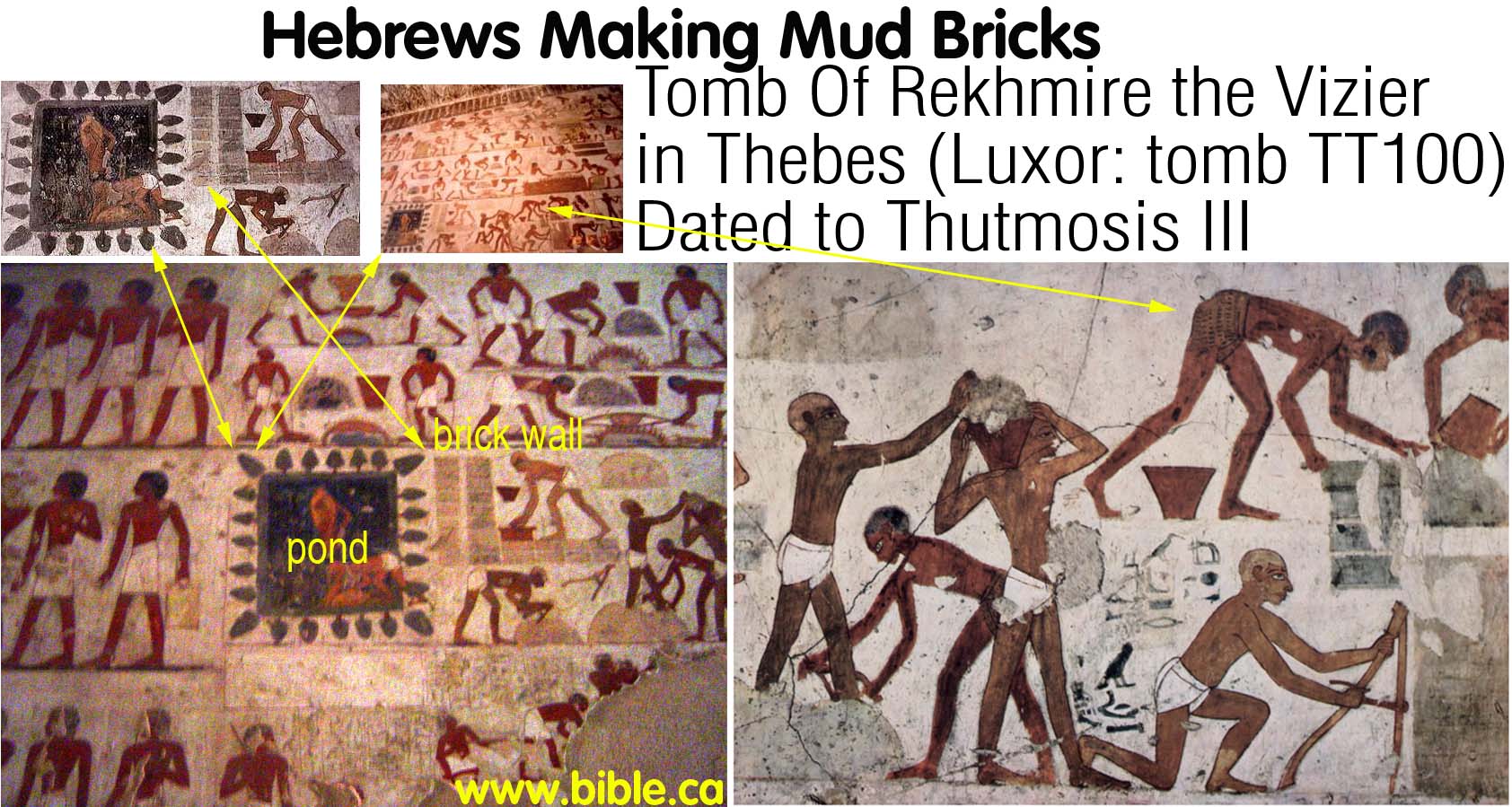
- Moses firstborn by adoption, Thutmoses III legally second born:
There are two reasons why Thutmoses III survived the tenth plague even though he was biologically first born. First, it seems from the narrative that even if Thutmoses III was the first born, he was exempted from the 10th plague. God told Moses that after the death of the firstborn, Pharaoh would let Israel Go, not that the 10th plague would kill him. The whole point was to humiliate Pharaoh, not kill him. The second reason Thutmoses III did not die, is because he was not the legal "firstborn", merely the biological firstborn. Moses had been adopted into the family and took the legal place of firstborn and therefore heir to the throne. The matter of succession would have become a point of conflict between Hatshepsut and her husband Thutmoses II, once Thutmoses III was born. Thutmoses III would have surely been make fully aware of this huge family fight and it was in his best interest to side with biology. However Moses left the matter unresolved when he fled for Midian. The question would have lingered in Thutmoses III's mind until he got his answer in the 10th plague that Moses really was the rightful firstborn heir to the throne he sat upon. There are other examples in the bible that have the rights of firstborn granted to the biologically second born in Esau and Jacob. Jacob gained birthright by a meal. Moses gained it by adoption. Likewise Christians gain the full rights of God's children by adoption. When Moses first shows up and demands that his step brother "Let Israel go", it was a bizarre irony. Here you have Moses, the rightful legal heir to the very throne that he turned his back on, demanding of Thutmoses III to let Israel go. The pride and the rivalry must have been enormous for Thutmoses III. After 9 plagues, Moses stands before his step brother and says that the first born will die. Thutmoses III had to emphasize his claim as firstborn, in order to gain the throne! Moses' statement that all the firstborn of Egypt would die caused terror to enter Thutmoses III's heart. The fact he did not die, proved that Moses was in fact first born and the living rightful pharaoh of Egypt. Had Moses pressed his claim, Thutmoses III would have been seen as a usurper! When Moses said, "you will never see my face again", it struck terrifying fear into Pharaoh that he was going to be a victim of the 10th plague, being a first born himself. Thutmoses III had 9 plagues as proof Moses meant what he said. He wondered if he were going to die as firstborn. He would have mediated in terror what Moses meant by: "you will never see my face again"! He was sure he was a dead man! When he didn't die, this personal terror turned into panic and is what finally motivated him to drive Israel out early in the morning of Nissan 14. We have an awesome God! - Thutmoses III did not die in the red sea:
The Pharaoh of the Exodus did NOT die in the Red Sea. The Bible nowhere says Pharaoh drowned in the Red Sea. Further, drowning in the Red Sea was the easy way out. It was far more humiliating for Thutmoses III to have to travel back to a destroyed Egypt WITHOUT his army to face his people. Some will actually rule out Thutmoses III as a candidate for the Pharaoh of the Exodus BECAUSE he died 15 years after the Red Sea crossing in 1431 BC. This is a great example of where incorrect assumptions will lead you on a fruitless rabbit trail to error in choosing the WRONG Pharaoh of the Exodus. With all the factual errors in the classic 4 hour Hollywood movie, "THE TEN COMMANDMENTS" with Charlton Heston, the spectacular scene where Pharaoh army are drowned before his eyes and he drops his staff is exactly correct!
· Notice the account carefully differentiates Pharaoh from HIS ARMY: "Then the Egyptians took up the pursuit, and all Pharaoh’s horses, his chariots and his horsemen went in after them into the midst of the sea. At the morning watch, the Lord looked down on the army of the Egyptians through the pillar of fire and cloud and brought the army of the Egyptians into confusion. He caused their chariot wheels to swerve, and He made them drive with difficulty; so the Egyptians said, “Let us flee from Israel, for the Lord is fighting for them against the Egyptians.” Then the Lord said to Moses, “Stretch out your hand over the sea so that the waters may come back over the Egyptians, over their chariots and their horsemen.” So Moses stretched out his hand over the sea, and the sea returned to its normal state at daybreak, while the Egyptians were fleeing right into it; then the Lord overthrew the Egyptians in the midst of the sea. The waters returned and covered the chariots and the horsemen, even Pharaoh’s entire army that had gone into the sea after them; not even one of them remained." (Exodus 14:23-28)
· In the victory song of Moses notice it never says Pharaoh himself drowned: "Pharaoh’s chariots and his army He has cast into the sea; And the choicest of his officers are drowned in the Red Sea." (Exodus 15:4)
· Notice God "shook off" Pharaoh but didn’t' kill him: "But He overthrew Pharaoh and his army in the Red Sea" (Psalm 136:15) The Hebrew word for "overthrew" is literally "shook off" and is metaphoric of ridding the Hebrews of Pharaoh's control. It DOES NOT say that Goddrowned or killed Pharaoh and his army in the Red Sea
- Thutmoses III's annual campaigns ended in 1446:
Thutmoses III made 17 yearly military conquests into Canaan that started in his second year and continued every year until his 18th year which was 1406 BC... the exact date his army drowned in the Red Sea. Remember that his campaigns did not start until after his step mother Hatshepsut died in 1464. Upon the death of Hatshepsut, Thutmoses III finally became king of Egypt apart from his step mother's co-regency. In the 34 years that Thutmoses III ruled after Hatshepsut died, he launched 17 military campaigns into Canaan and Syria, and Nubia (southern Nile). What everyone has missed is that the yearly campaigns ended in 1446 BC because his army was drowned. This is stunning when you realize his annual campaigns ended because his army lay 1381 meters (4530 feet, almost a mile) under water at the Straits of Tiran. After 17 annual campaigns, the 18th campaign of 1446 never happened! Nothing in the Bible says that Thutmoses III died with his army in the Red Sea. In fact, archeology has demonstrated that when navigating a mountain pass or a narrow valley, Thutmoses III, who would normally lead his armies on foot, would wait till every one of his soldiers got through safely. This stunning fact explains why his army died in the Red Sea but he survived! - Defacing and erasure of Hatshepsut by Thutmoses III started in 1446:Immediately after the Exodus, Thutmoses III erased all evidence of both the Hebrews in Goshen and his step-mother, Hatshepsut for adopting Moses into the royal family. The well documented erasure of Hatshepsut from records and monuments began after 1446 BC at the hand of Thutmoses III. The erasure of Hatshepsut from history did not occur before his 42nd regnal year (year 20 after Hatshepsut died) which brings us to exactly 1443 BC, which is three years after the exodus! Another perfect fit! Even if the exact regnal year is wrong, the key is that the erasure occurred either AFTER the Exodus, not before. Bible trashing historians dismiss the exodus as myth and make it their primary goal is to hide any connection between Egypt and the Exodus. These Bible hating archeologists suggest that Thutmoses III was motivated by sexist male revenge against an "overbearing and dominant wicked feminist step-mother who usurped her female place in a male dominated world"! But this is a ridiculous and strained explanation given the fact that Thutmoses III waited 21 years after the death of Hatshepsut to erase her memory. The anger and revenge of Esau to kill Jacob for stealing the title of first born, had fully subsided after 21 years. (An amazing co-incidence in both numbers and the usurping of the firstborn birthright.) Douglas Petrovich comments: "If Thutmoses III was the culprit [of erasure], he must have had sufficient motive to attempt to prevent her from living eternally. According to Egyptian religion, removing the name or image of a deceased person was a direct assault on his/her spirit. For him to live forever in the Field of Reeds, his body, image, or name must survive on earth. If all memory of him were lost or destroyed, the spirit too would perish, initiating the much-dreaded "second death," a total obliteration from which there could be no return. This act against Hatshepsut was an attempt to 'condemn her to oblivion - a fate worse than death for an Egyptian.' Thus the extermination of Hatshepsut's image from the earth was indeed a drastic step: the removal of her spirit from its perpetual existence in the afterlife. Such reprisal seems far too severe to fit the motive of mere sexism." (Amenhotep II and the Historicity of the Exodus Pharaoh, Douglas Petrovich). We are reminded that Bible scoffers try to dismiss the exodus as myth because they find little evidence of the Hebrews in Egypt. Well here is a documented example of the pharaoh of the Exodus erasing the history of his step mother! Obviously the exodus Pharaoh would take every step possible to erase any trace of the "Habiru" from Goshen.
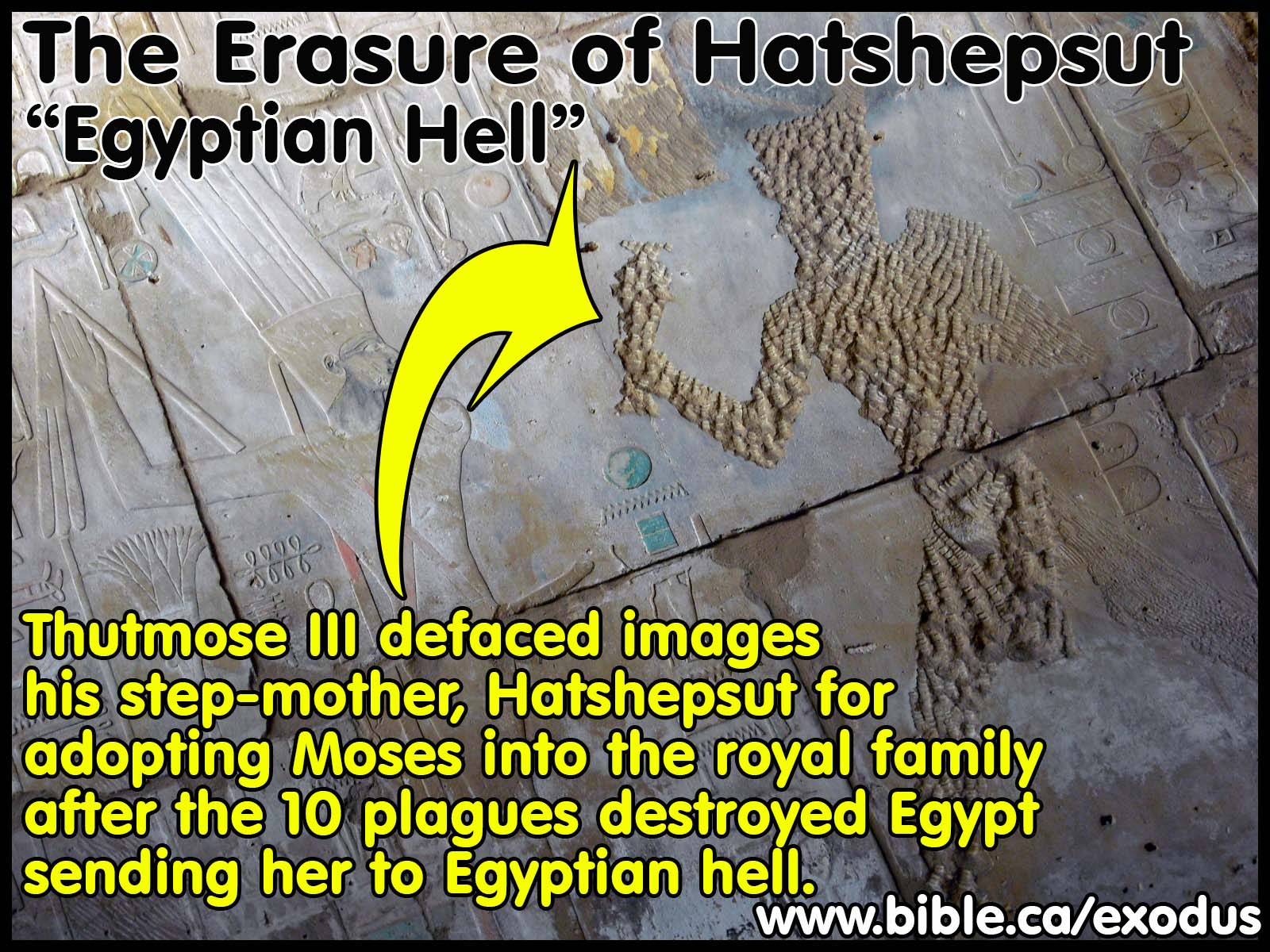
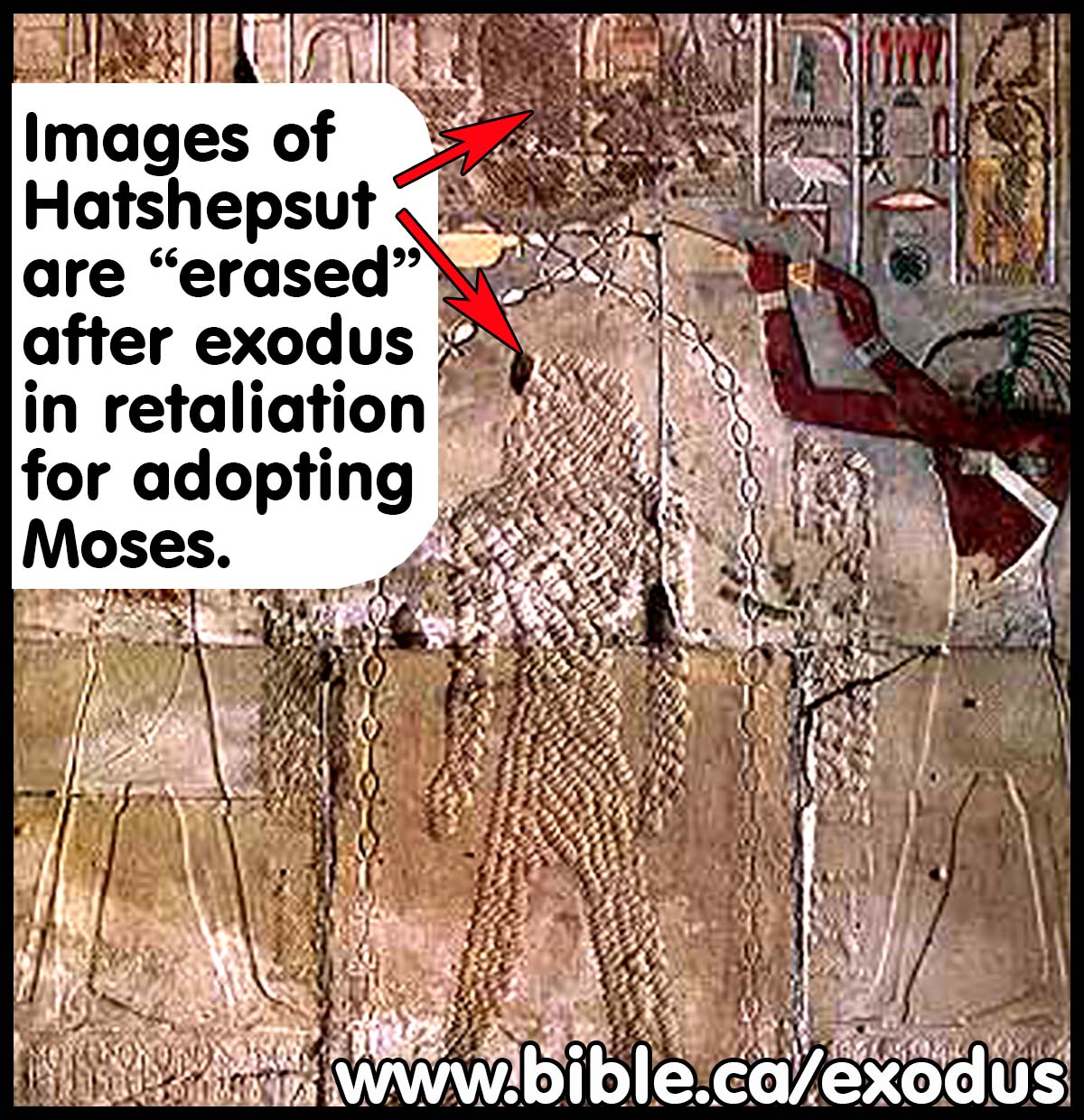
- Defacing and erasure of Senenmut (or Senmut) by Thutmoses III in 1446:Thutmoses III blamed the destruction of Egypt at the Exodus on his step mother Hatshepsut for adopting the Hebrew slave into the royal family as heir to the throne of Egypt. After the Exodus, he not only ordered the erasure all images of Hatshepsut, he did the same to a man known in history as "Senenmut". But why? Thutmoses III was a baby when his father died and he inherited the throne, since Moses had very recently fled to Midian. This explains why Hatshepsut ruled as his co-regent with her step son, Thutmoses III for 21 years until her death. The Cairo museum has a statue of "Senmut" with a baby's head in front. (see below) Senmut was an elderly man whom Hatshepsut trusted. He is often pictured with Neferure (daughter of Pharaoh) as a child. This is the correct interpretation. Being an old man, it may be that Senmut was Hatshepsut's nurse, as well as Thutmoses III's and Neferure's (Hatshepsut daughter). Thutmoses III not only defaced Hatshepsut, but also Senmut as well. The reason is because Senmut was one of Hatshepsut's most trusted advisers. Perhaps he was seen by Thutmoses III, as being a contributor to the exodus disaster that came upon Egypt.
Wild Speculation and Fiction:
Myth #1: In the statues, the adult is Hatshepsut and the child is Moses.
Myth #2: Neferure = Hatshepsut = Nefure.
Myth #3: Hatshepsut did not have a daughter named Neferure. Neferure is Hatshepsut.
Myth #4: Senmut = Moses = Hatshepsut Xnem Amen = Thutmoses II.
Myth #5: The statues memorializes baby Moses under the care of the daughter of Pharaoh.
Myth #6: Moses actually became Pharaoh with the title Thutmoses II.
Facts: In the statues, the adult is Senmut and the child is Neferure. Neferure was the daughter of Hatshepsut. The name Nefure is never applied to Hatshepsut but is a fictional invention. Hatshepsut married Thutmoses II not Moses. However because it is a fact that Hatshepsut wore a fake beard and took on the male persona later in her reign, some mistakenly believe the adult in the statue is her, not the male servant Senmut (or Senenmut). The speculation is that the adult is a "fake bearded Hatshepsut" (aka Neferure) and the baby is Senmut being another name for Moses. The fact that Senmut appeared to remain single his whole life, (probably because he was a eunuch), disappeared mysteriously and his tomb was unfinished, has fueled speculation that the Senmut is Moses who also was single in Egypt, who suddenly disappeared when he fled to Midian and whose tomb was never finished and remained empty because he died on Mt. Nebo! The conclusion is that the adult is just plain old male Senmut, a trusted steward of Queen Hatshepsut, and Thutmoses III defaced his statues because of Senenmut's obvious close role he played in association with Hatshepsut. The statue in the Louvre museum shows Senmut as a male. You can see his nipple. Important women in Egypt, like women today, wear tops! So that settles it. There are no bearded statues of a topless Hatshepsut with nipples showing. These show her bearded but fully clothed with obvious breasts under her shirt. So the adult is a male! That means that the baby is what the inscription on the stone below says: "Neferure: daughter of Pharaoh." Remember that Senmut literally means, "mother's brother" which fits well with an older trusted servant. Senmut is not Moses, Neferure is not Hatshepsut. However, it is entirely possible that Senmut, being Hatshepsut's "mothers brother", was the official "eunuch guardian" that cared for Hatshepsut as a baby, Moses, Thutmoses III and Neferure! Thutmoses III defaced both Hatshepsut and Senmut statues and wanted to erase them both from history as a direct result of the exodus in 1446 BC. Until they find a statue of Senmut with an inscription saying it is Moses, it is best to ignore such rabid speculation. But the fact remains, that Thutmoses III defaced both Hatshepsut and Senmut statues immediately after the Exodus!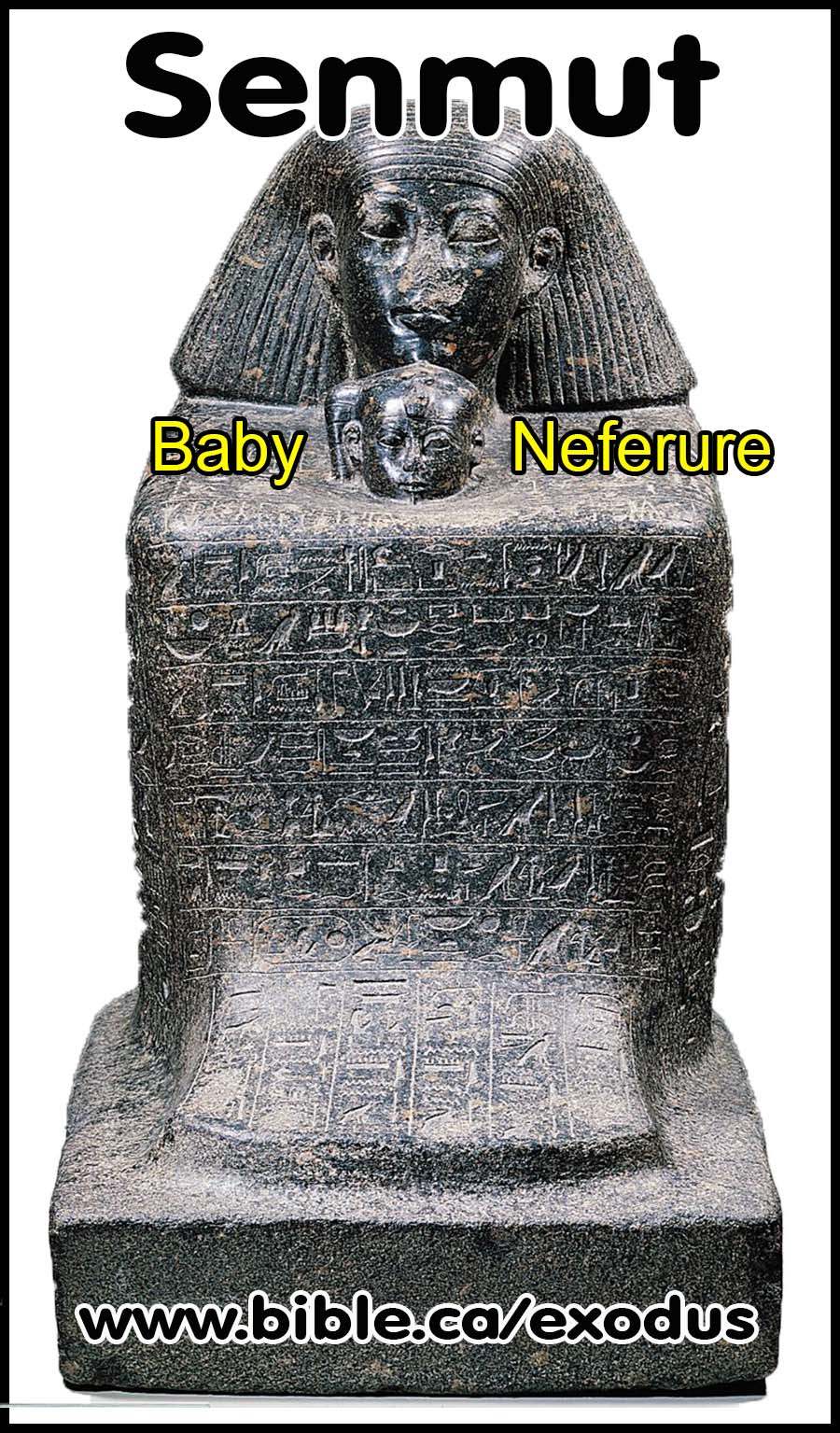
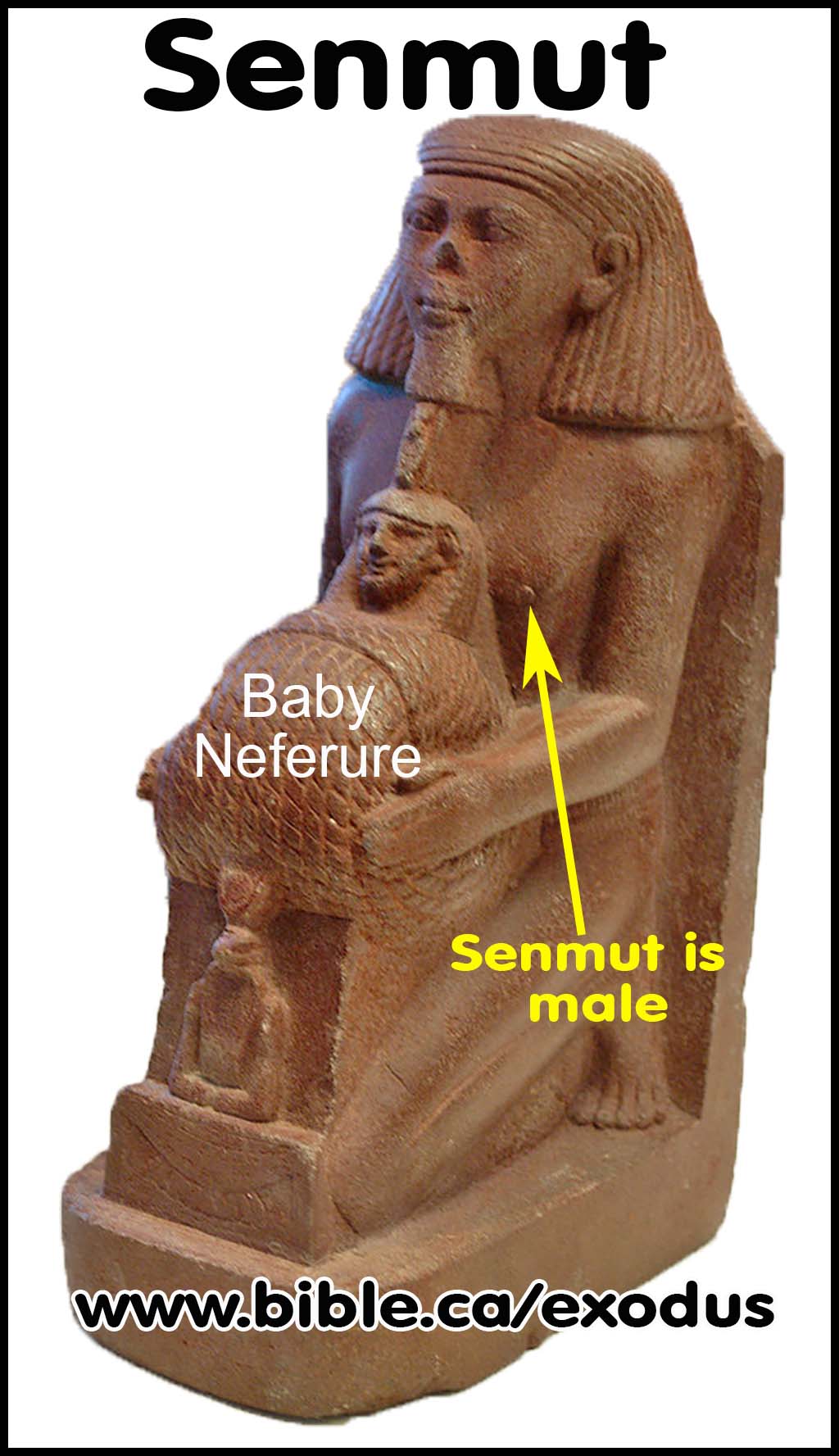
- Amenhotep II was "second born" son of Thutmoses III: 1431-1406
Thutmoses III firstborn son "Amenemhat", by Queen Merytre-Hatshepsut was killed by the tenth plague. It is well documented that Amenhotep II, was Thutmoses III's second born son by Queen Satiah, who became Pharaoh in 1431AD. In the providence of God, this is a well documented fact. However, those who wrongly believe Amenhotep II was the pharaoh of the exodus, have no evidence that his firstborn son died. In other words, we are 100% sure that Amenhotep II was not firstborn and 0% that Amenhotep II firstborn son died before he did. - Replacement Slaves in 9th year of Amenhotep II: 1422 BCAmenhotep II had to go on a raid to replenish his 3 million lost Hebrew slaves. Amenhotep II records his two campaigns, highlighting only his successes where he broadcasts his power, might, courage, leadership, military successes and largely inflated figure of 101,128 slaves captured in Canaan in his 9th year campaign in 1422 BC. After Egypt had taken such a thrashing from the 10 plagues and Amenhotep II had to invade Canaan to capture more slaves, it was a prudent self defense strategy to make other nations think twice about invading Egypt. In truth, the year 9 campaign was more about refueling a devastated nation, rather than a truly powerful display of military might like those of his father, Thutmoses III before the exodus. The boastful and exaggerated records of Amenhotep II are therefore a poker bluff when you only have a pair of twos in your hand, whereas everyone knew Thutmoses III had four aces! The Stela at Memphis records this: "A record of the plunder that his majesty carried off: 127 princes of Retenu; 179 brothers of princes; 3,600 Apiru [or Habiru Hebrews at Kadesh Barnea]; 15,200 Shasu; 36,300 Kharu; 15,070 Nagasuites/Neges; 30,652 of their family members; total: 89,600 people, and their endless property likewise; all their cattle and endless herds; 60 chariots of silver and gold; 1,032 painted chariots of wood; 13,500 weapons for warfare." (Amenhotep II, Memphis Stela, 2nd campaign, year 9, 1422 BC) Strangely, the total in the stela is 89,600, but the sum of the individual numbers add up to 101,128. Whereas Amenhotep II captures 3600 Apiru, the Amarna Letters record the later conquest of Joshua and uses the equivalent word Habiru. Therefore we know that Apiru = Habiru = Hebrews. The Memphis Stela documents Amenhotep II's two campaigns. The first into Syria in year 7 (May 15), and the second into Canaan and Edom in Year 9 (Nov 15). However the Amada Stela and Elephantine Stela both indicate the first campaign happened in year 3 (July 4). In year 9 (1416 BC), Amenhotep II signed a peace treaty with the king of Mitanni. The capture of 3600 Apiru (Hebrews) would have been in 1416 BC which meant he captured them while Israel had already been camped at Kadesh Barnea for 22 years. The 38 years at Kadesh is generally one of silence with only a few events revealed in the Bible. We are not told about the loss of 3600 Jews to Pharaoh Amenhotep II while Israel was at Kadesh Barnea. However, they may have been a group that simply abandoned Moses and surrendered to Egypt. "We remember the fish which we used to eat free in Egypt, the cucumbers and the melons and the leeks and the onions and the garlic, but now our appetite is gone. There is nothing at all to look at except this manna." Numbers 11:5-6. The Bible records more than once, that Israel mutinied Moses and started marching back to Egypt. "So they said to one another, "Let us appoint a leader and return to Egypt."" Numbers 14:4. After all, they had been told they were going to die at Kadesh, so being enslaved in Egypt may have been an upgrade in living standards! Evidently 3600 of these Jews got their wish and were once again enslaved in Egypt by Amenhotep II. Good riddance!
- Amenhotep II (second born son of Thutmoses III) dies the exact year Joshua crosses the Jordan in 1406 BC! In fact, it may have been the news of successful conquest that made Amenhotep II fall backwards and break his neck! It is curious that the pharaoh who survived the 10th plague, died the year those runaway slaves became a nation with land of their own!
- Thutmoses III's campaigns made the conquest easier:
Thutmoses III made 17 military conquests that softened up Canaan for the eventual conquest of Israel 40 years later. Amenhotep II had one campaign into Canaan year 9, 1416 BC, when Israel was at Kadesh Barnea year 22. The yearly wave of 17 attacks into the promised land by Thutmoses III and the single attack by Amenhotep II directly before the conquest, weakening the Canaanites making it easier for the Hebrews to take the land under Joshua in 1406 BC. The text of the Victory stele of Thutmoses III boasts his victories over Canaan, Nubia, Mesopotamia, Phoenicia, Cyprus, Asia Minor, Greek Archipelago.
- Amarna Tables: conversion of Akhenaten to monotheism.
See: The Amarna Tablets which chronicle the conquest of Joshua. One of the most stunning events in religious history is the conversion of Akhenaten to monotheism in 1358 BC. Akhenaten becomes Pharaoh only 2 years before Joshua died in 1356 BC. Akhenaten became king in 1358, reigns 17 years and dies in 1341 BC. He became the first Pharaoh to witnesses the former Hebrew slaves become a conquering nation. While they were at Kadesh Barnea living a meager material existence with manna in the middle of nowhere, the Pharaohs would chortle that the Hebrews would have been better off staying in Egypt. When they crossed the Jordan into a territory controlled by 7 nations more powerful than Israel, the Pharaohs would cluck and scoff that they were doomed. But when they succeeded in taking over the entire land of Canaan in the period directly preceding Akhenaten's ascent to the throne, he could only be impressed with the monotheistic God of the Hebrews. This is why Akhenaten converts to pagan monotheism in the worship of the sun god, "Aten". The Amarna Letters fully document the Habiru (Hebrews) conquest of Canaan. After Akhenaten died, his son Tutankhamun became Pharaoh as a child. Regrettably, the governors of young King Tut forced Egypt to revert back to polytheism. Tutankhamun is then murdered and buried with the artifacts of his father Akhenaten. In the Amarna Tables, the "Habiru" are the Hebrews during the conquest of 1406 BC: "The Habiru are now capturing the fortresses of the Pharaoh. Not a single governor remains among them to my lord the King: all have perished. Zimrida of Lachish has been killed. May the King send help. Lo, if no reinforcements come this year, all the countries of my lord the King will be utterly destroyed. ... The land of the King is lost to the Habiru. And now indeed a city of the territory of Jerusalem, Bet-Ninib, has been captured. ... After taking the city of Rubuda, they are now attempting to take Jerusalem... , What have I done against my lord the King, that thou lovest the Habiru, and hatest the governors? ... The Habiruhave wasted all the territory of the King', and so on." (Amarna Tablet, A Letter from Abdu-Heba of Jerusalem, EA 286) "They are now attempting to take Jerusalem. ... Gezer, Ashkelon, and Lachish have given oil, food, and supplies to the Habiru. ... Labaya and the land of Shechem have given all to the Habiru." (Amarna Tablet, A Letter from Abdu-Heba, EA 287)
The Amarna Tables (left). Akhenaten worships Aten with his wife and his firstborn, King Tut (Tutankhamun) on her lap.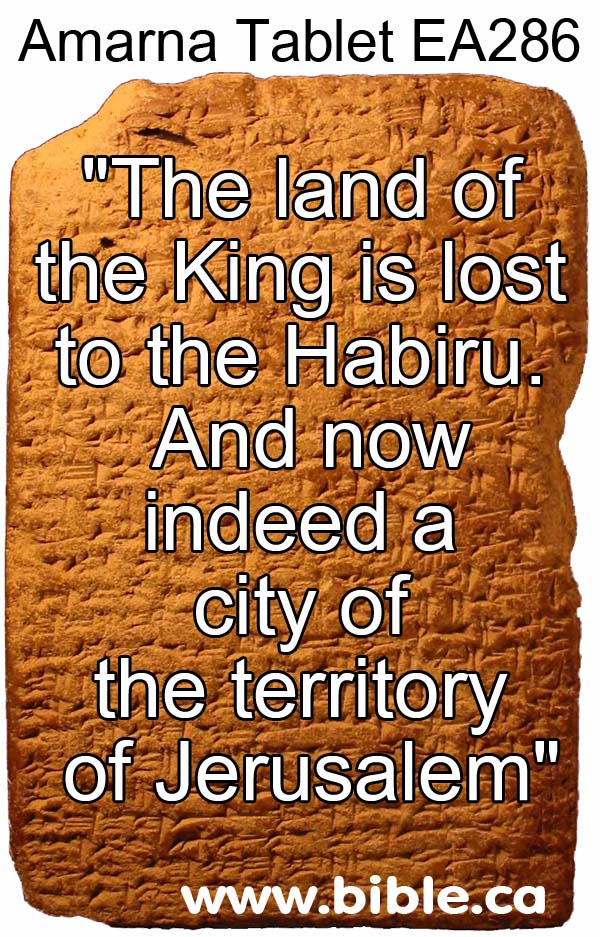
The Exodus out of Egypt:
Archaeology Generally Confirms Biblical History
| Admittedly, there is not an abundance of specific archaeological evidence to confirm each particular event in the biblical account of God delivering the people of Israel out of Egypt through Moses, as described in the book of Exodus --however, since the Hebrews in Egypt were slaves to begin with, and then they continued to be nomadic for a period while returning to the land of Canaan, finding tangible traces of such a history may be similar to trying to prove archaeologically what the nomadic conqueror, Attila the Hun, specifically did in his life.--Still, there is --in broad brush-strokes-- a fairly good body of evidence confirming the Bible's overall account of the Exodus of the Hebrews out of Egypt, some of which will now be described. |
Hebrews in Egypt
In an article entitled, "Egypt and the Palestinian Connection in the Second Millennium BC," Dr. Manfred Bietak (Egyptologist and head of the Austrian Institute of Archaeology) gives the following summary of the relationship between Egypt and inhabitants of Canaan (Palestine) around the time of the Exodus:
| After the interlude of the First Intermediate Period (2200-1970 BC) Egypt started its contacts with Palestine. Mercantile relations were only interrupted from the Second Part of the 12th dynasty onwards (ca. 1900-1800 BC). This can be assessed by imports within the stratigraphy of Ezbet Rushdi and Egyptian exports to Tel Ifshar. It seems that during the late 12th dynasty the Egyptian crown granted liberal access to the town of Tell el-Dab'a (Eastern Nile Delta) which seems to have become something like a free trading town, otherwise the marked increase of settlers of Syro-Palestinian origin in the size of approx. 25,000 inhabitants cannot be explained. Whilst trading links with the Northern Levant (Byblos) dominated, during the Second Intermediate Period the main Egyptian trading partners were situated in Palestine. Finally a local dynasty appeared at Avaris/Tell el-Dab'a which took from ca. 1640-1530 BC control over all of Egypt. They are known as Hyksos. They also controlled a part of Palestine. Relations with Palestine flourished at this time. After the expulsion of the Hyksos by the Egyptian 18th dynasty, the major part of Palestine remained independent till Thutmosis III and the battle of Megiddo (ca. 1459 BC)." |
It is usally understood that the "Hyksos" invaders, who finally gained temporary control of Egypt from about 1720 B.C. until 1570 B.C., were various immigrant Semitics from Palestine (Canaan), Assyrians, and Amalekites, many of whom originally had a nomadic lifestyle or were driven to Egypt by bad agricultural conditions. Some of the Hyksos were peaceful immigrants who moved into Egypt for many years, while others acted more like "invaders," exhibiting more violent behavior, such as the pillaging of some Egyptian villages.
(ref: "Who Were the Hyksos" by Troy Fox, in Tour Egypt website, at: http://www.touregypt.net/featurestories/hyksos.htm)
In 1966, Manfred Bietak --head of the Austrian Institute of Archaeology-- excavated ruins at Avaris (Tel el-Dab'a) in the Nile Delta, and discovered a settlement of "Asiatics," which is a term that Egyptians used for people from Canaan/Palestine. The inhabitants of Tel el-Dab'a were not Egyptians, but were Semitic Canaanites. They were of the Syro-Palestinian Middle Bronze Age Culture, and none of the remains are Egyptian. Significantly, the U-shaped floor-plans, and the walls of their buildings are exactly like those later constructed by the Hebrews inIsrael. In addition, their burial methods were different than the Egyptians. This particular Semitic settlement at Tel el-Dab'a had a population of about 30,000 people, and is dated as being from the Late Hyksos or the early 18th Dynasty of Egypt. This time would be not long after the time of Joseph (see Genesis chapters 37-50) --perhaps somewhere around 1500 BC.
Thus, we have direct archaeological evidence of the presence of at least several tens of thousands of Semites with Hebrew culture established in cities in the Nile Delta around the very time that the Bible says the Hebrews were there.
Enslaved in Egypt
Next, we do find a number of writings which clearly indicate a sizeable number of Syro-Palestinian slaves in Egypt around the 1300s BC. --James Hoffmeier of Wheaton College points out that after the "Hyksos" dynasty in Egypt was overthrown, "Egypt was teeming with Semitic-speaking peoples," whom the Egyptians then treated as prisoners of war and slaves. This turn-around of the Hebrews starting out as free inhabitants but becoming enslaved in Egypt, parallels with the biblical account. Hoffmeier adds that the presence of Israelites among these Semitic slaves is very likely.
--Thus, it so happens that at the time the Hebrews would have been enslaved, there are actually Egyptian inscriptions to verify the fact.
--The word "Apiru" meant a "state-less" individual, and many scholars think it was used to refer to the Hebrews --and indeed, Dr. Frank Moore Cross of Harvard University directly says that "the term 'Apiru' is the origin of the term Hebrew."
--The Apiru (Hebrews) were being employed as slaves in Egypt.
The book of Exodus states that 600,000 Israelite adult males (over the age of 11) left Egypt, and if women are added to that number --bringing the Hebrew population to perhaps 1.2 million--, then these numbers are within tolerances of what is possible at the time ...and remember, that not all of the Israelites would have been counted as slaves. --And it should also be remembered that there may have been a number of smaller "exoduses" over the course of several years, with a larger exodus which typified "the Exodus" of the Hebrews out of Egypt.
Desert Wanderings Some have wondered: If there were so many Israelites involved in the Exodus, where is the evidence of more than a million of them wandering through the desert? -- In answer of this, two main things should be taken into account:
1. The Scripture records that the movement of the Hebrews was almost constant, and they did not stay in any one place for more than a few days or perhaps a week or two, and as a result, such brief encampments would not involve much land-clearing, and wouldn't leave significant amounts of objects behind which would survive the centuries.
2. After the Israelites refused to invade and take over Canaan, the judgment was that a whole generation would die in the wilderness, until there were only about 80,000 left at the end of 40 years, who finally entered into Canaan.
Hebrews Re-Inhabit Canaan
Some time around the 14th and/or 13th century BC we find good evidence of the return and influx of Hebrews back into the land of Canaan.
At Tel Amarna, Egypt, cuneiform tablets from about the 14th c. BC were discovered, and they contain urgent pleas to the Egyptian Pharaoh Akenaten, asking him to do something about the "Apiru" which were invading in sizeable numbers and taking over parts of Canaan. --And again, as mentioned earlier, Dr. Frank Moore Cross of Harvard Universtiy states that the term "Apiru" is "the origin of the term 'Hebrews'." So, at about this time, there is a return and major influx of Hebrews back into Canaan --in large enough numbers to cause alarm in the current residents, and a plea to higher authorities in Egypt for help.
To confirm this "invasion" picture further, consider several lines from the Victory Stele of Pharaoh Merneptah, which was found in his funerary temple in Thebes. That granite monument has lines of heiroglyphics which commemorate the conquests of Merneptah in Canaan in about 1210 BC. Some of those lines read:
Plundered is Canaan with every evil; Carried off is Ashkelon; seized upon is Gezer Yanoam is made as that which does not exist; Israel is laid waste, his seed is not."(ref: Ibid, J. Sheler, p.80) |
Although we may overlook the usual exaggeration used to glorify the Pharaoh, these statements are nonetheless a specific archaeological confirmation of the return of substantial numbers of "Apiru" (Hebrews / Israelites) to the land of Canaan, specifically and clearly demonstrating that by the year 1200 BC "Israel" was indeed a sizeable and organized national power, with which the regional power (Egypt) had to recon. --This is beyond dispute.
Population Boom
At the same time as the influx of the "Apiru," Dr. Lawrence Stager of Harvard University discovered that during the 12th century BC, there was an accompanying increase in the number of villages in the hills on the West Bank of the Jordan River (between Hebron and Shechem) --an area of about 2,600 square miles. In that area alone, the number of villages increased from 23 to about 114, and the population balooned from about 14,000 to about 38,000. This is almost a trippling of the population in about a century's time, which cannot be accounted for by just the birth-rate --there must have been a sizeable influx of Apiru (Hebrews) from outside of Canaan.
William Dever indicates that the characteristics of those new villages (including the artifacts found in them) "provide an archaeological assemblage that agrees remarkably well" with the cultural trappings of Hebrew life-styles and the situation which the Bible describes as the returning Hebrews re-settled the land of Canaan.
A Haifa University archaeologist on Monday [April 27, 2009] said he has unearthed structures in the shape of human feet believed to have been erected by the Israelites upon their initial entry to the Land of Canaan. Prof. Adam Zertal said that the large compounds discovered in the Jordan Valley were "the first sites to have been built by the Israelites upon entering Canaan and manifest the biblical notion of claiming ownership of the land by setting feet on it." Prof. Zertal's excavation team uncovered five large foot-shaped compounds that he identifies as the biblical site of Gilgal. Zertal's most famous discovery is a compound on Mount Ebal near Nablus, which he identified as the site of the Covenant ceremony depicted in the biblical Book of Joshua. Other archaeologists have identified that site as a watchtower. Since 1990, five sites shaped like human feet have been excavated in the Jordan Valley. All five date back to the early Iron Age (12th to 13th centuries B.C.E.), and their shapes indicate that they were used as communal gathering places. Zertal said that the foot-shaped sites were used during ceremonies following the Israelites' entry into the Land of Canaan. He added that the concept of the Jewish pilgrimage to Jerusalem on three major holidays (known as "aliya la'regel" or ascending on foot) also originates from the foot-shaped sites in the Jordan Valley and Mount Ebal. |
An Exodus Did Happen
When the above facts of the many thousands of Semitic-speaking Canaanites (Hebrews) who had been enslaved in Egypt are considered, along with the "expulsion" of the Hyksos from Egypt (to which Dr. Bietak referred) --followed by the Apiru (Hebrew) invasion and settling of Canaan-- then we are compelled to conclude that there must have been an exodus of large numbers of Hebrews (Apiru) out of Egypt (or possibly several smaller "exoduses"), who then invaded and re-settled the land of Canaan, establishing the people of Israel --and these "Apiru" (Hebrews) are then specifically identified as the nation "Israel" with whom Pharaoh Merneptah fought. --This is archaeological fact, not speculation.
In view of this overall picture, it seems obvious that there was a significant Exodus of Hebrews out of Egypt --even though more precise dates and numbers of people may not be archaeologically specified and confirmed. --Thus, it would seem somewhat ignorant --perhaps arrogant-- for anyone to unequivocally state that "there was no Exodus" (as a few do).
Perhaps the archaeological evidence is not quite as specific at the beginning of the Hebrew history as some would like, but since the people of Israel had their beginning with small numbers (70 people) and their exodus occurred in a time of slavery --as an embarrassment to the Egyptian Pharaoh-- then one would actually expect to find minimized records of them in Egypt.
--William Dever points out that "Slaves, serfs and nomads leave few traces in the archaeological record." Whatsmore, Egyptian rulers did not immortalize their defeats (especially by slaves!) on their temples and pyramid walls.
--Writing for the Bible Review magazine, Peter Feinman humorously suggests how someone ignorant of ancient Egyptians might expect the record of an Egyptian humiliation by Moses to have read:
| "A spokesman for Rameses the great, Pharaoh of Pharaohs, supreme ruler of Egypt, son of Ra, before whom all tremble in awe blinded by his brilliance, today announced that the man Moses had kicked his royal butt for all the world to see, thus proving that God is Yahweh and the 2,000-year-old culture of Egypt is a lie." |
The Man Moses
Although the man Moses has not yet turned up in extra-biblical sources, it is intriguing that the name itself is from the Egyptian name "Mose,"meaning "(he) is born". This name "Mose" is orginally Egyptian and not Hebrew --and in Hebrew the name is "Moshe," which is how it is used by Israelis today.
As Egyptians used the name, "Mose" was often combined with another name, resulting --for example-- in the names of a number of pharaohs, such as "Thut-mose," which means "Thut is born," --or "Ra-messes," which means "Ra is born."
The biblical account says that Moses (Moshe) was raised in the Egyptian royal court by Pharaoh's daughter, and given the name Moses (meaning "[He] is born"). Baruch Halpern notes that this story "mirrors the practice of Egyptian kings raising the children of their Semitic vassals as hostages in the court."
It is maintained by some, that the chronology for the exodus event is a serious problem for the book of Exodus. This is because 1Kings 6:1 states that the fourth year of Solomon's reign was four hundred and eighty years after the Israelites came out of Egypt --and since that point in Solomon's reign was about 962 BC, therefore the exodus must have occurred in about 1438 BC. --The problem is: 1438 BC is perhaps about 150 years off from what some say is a likely date for the Exodus event with Moses. Exodus 1:11 notes that the Hebrew slaves were employed in the building of Pharaoh's "storage cities, Pithom and Rameses," and many egyptologists now think that these cities were built mostly by Ramesses 2, about 200 years after the exodus date, so, the Israelite's wouldn't have been there to do the building.
This problem may be partly answered by the fact that the name of the city "Rameses" in Exodus 1:11 may be an editorial "updating" by someone who lived after Moses --whereas the city was not actually named "Rameses" right at first. This is similar to the way that Columbus is often said to have discovered "America," even though America --named as such-- did not yet exist.
In addition, evidence may show that the Exodus event actually happened in about 1446 B.C., which is exactly the right date to harmonize with the 480 years specified in the biblical text. Dr. Lennart Moller, in his book "The Exodus Case," gives what may be a reasonable and logical argument pointing to 1446 B.C. as the actual date of the Exodus under Moses --which lines up nicely with the 18th dynasty of Egypt.
But the chronology issue isn't necessarily a very damaging problem for the book of Exodus, however, because (as Nahum Sarna and others argue) the timespan of 480 years may definitely be taken as a symbolically rounded number. To the Hebrews, a generation was oftensymbolically considered to be 40 years, and 12 generations would then be called 480 years in a "schematized" chronology of rounded numbers, even though the actual literal number was plus or minus 150 years or so. --Similarly, Sarna further points out that based on the time-spans listed in 1st and 2nd Kings for the reigns of David and Solomon, as well as other events and eras, the Bible marks out another 480 years which passed from the start of the Temple in Jerusalem to the end of Israel's babylonian exile. Sarna maintains that this suggests a "schematized chronology" instead of a literal historical record with a precise chronology, because the biblical writers "wanted to place the Temple at the center of biblical history" (Sheler, p.79). This makes the 480 years a sort of "theological" statement, as opposed to a precisely historical one. --So, in light of such symbolic and schematized numbers for some biblical chronologies, the exodus event may very well be placed within the archaeological framework.
These sorts of discrepancies between various chronologies or genealogical lists in the Bible is not very shocking, because various lists have different functions: Some genealogies are familial, some are political-legal lists, and others are religious/theological in their purpose. Because their purposes aren't the same, different types of generational lists will reveal discrepancies, which is called "fluidity."
The NIV Study Bible states that "The most common type of fluidity in Biblical materials is telescoping, the omission of names "behind" the list, or "between the lines." Unimportant names are left out in order to relate an individual to a prominent ancestor, or possibly to achieve the desired number of names in the genealogy. Some Biblical genealogies, for example, omit names to achieve multiples of 7: For the period from David to the exile Matthew gives 14 generations (2 times 7), while Luke gives 21 (3 times 7) for the same time-period, and the same authors give similar multiples of 7 for the period from the exile to Jesus (Mt. 1:1-17; Lk. 3:23-38). --This does not constitute an actual contradiction, but lines up with the symbolic/theological purposes of the authors.
Crossing the Red Sea
The route which the Israelites took from Egypt to Israel is not at all clear, but a southern route through the Sinai Peninsula may seem preferable. Despite the lack of such clarity on the exodus route, the overall substantiation of the Exodus as an historical event should not be in doubt. --In addition, the identity of the body of water which was miraculously crossed is not clearly understood from the Bible --nor clearly shown from archaeological remains-- but still, there is some tentative or tantalyzing evidence and possibilities which have come to light.
The first issue in discussing the Red Sea crossing, is to determine:
The Location of the Red Sea Crossing
In his DVD-video entitled "The Exodus Revealed - Search for the Red Sea Crossing" (Questar, Discovery Media, 2002), Dr. Lennart Moller (a research scientist & marine biologist of the Karolinska Institut, in Stockholm, Sweden) along with other researchers have reasoned that the crossing path must be somewhere across the Gulf of Aqaba --which is part of the Red Sea-- for the following reasons:
- Moses hid in "Midian," which is evidently in the western part of today's Saudi Arabia. This is where Moses saw the burning bush on Mt. Sinai.
- In Galatians 4:25, the Apostle Paul states that Mt. Sinai is "in Arabia."
- Josephus states that Mt. Sinai was near the city of "Madian," whose ruins are near the town of El-Bad, near the Saudi Arabian west coast.
- Exodus 14:11 says that the people had gone "out of Egypt," therefore, it sounds like the crossing point did not start from an Egyptian beach --near the Gulf of Suez-- but it may have been over on the Gulf of Aqaba instead.
- Right after the Red Sea crossing, Moses and the people were directed immediately to Mt. Sinai --apparently in western Arabia-- so the crossing is likely to have been across the Gulf of Aqaba.
--- However, where along the shore of the Sinai Peninsula might the Israelites have started to cross?
Nuweiba Peninsula
Dr. Moller concluded that probably the only place where about a million people could have camped along the western shore of the Gulf of Aqaba would have been on the Nuweiba Peninsula ---a sandy peninsula and beach which can be located on a map by starting at the northern-most tip of the Gulf of Aqaba and then go 50 miles south. In Exodus 14:2, it says that the place where the Israelites camped is called "Pi-hahiroth," which means "mouth of the Gorges," which is a fitting description for Nuweiba Peninsula, since it lies along some mountains which form a gorge that opens out onto Nuweiba Peninsula. --Any other places where Israel is suggested to have crossed through the water do no lie along mountainous terrain, at the mouth of such a gorge.
Chariot Wheels
In Exodus chapter 14, the Bible states that after the people of Israel had crossed over on the floor of the Red Sea, God caused the military chariots of Pharaoh to follow after the Israelites to try to kill them, but after the chariots had been driven down onto the sea floor, Moses stretched out his hand, and "the sea returned to its normal state ...and the waters returned and covered the chariots and the horsemen," and they perished.
Having concluded that Nuweiba Peninsula was the most likely candidate for the crossing, Dr. Lennart Moller and his researchers got scuba equipment, and started diving off of Nuweiba Peninsula and searched along the Red Sea floor to see if they could find evidence of the exodus crossing --and what was found was astounding.
Dr. Moller's DVD ("The Exodus Revealed") has underwater motion video of artifacts on the Red Sea floor, such as the ones seen below.
 |
Here we see the picture of a weel-shaped object lying on the Red Sea floor off of Nuweiba Peninsula, which is the right size and has the dimensions of 13th century BC Egyptian chariot wheels. The wheel is sheet-metal, and is apparently made of "electrum," which is a mixture of gold & silver. The sheet-metal electrum was used to cover a wooden wheel on an Egyptian officer's chariot, but the wood has decomposed over time, and the researchers did not move the sheet-metal covering because it may be too delicate to disturb, and the Saudi Arabian government also wouldn't allow the distubing of artifacts, nor the removal of any coral.
Notice that the wheel has a rim, four spokes, a hub, and a hole in the hub through which the axle extended. A little coral has tried to grow on one spot by the hub, but coral couldn't get started on most of the wheel, because gold and silver are not suitable substrates on which coral can start growing.

Here is another wheel-shaped object, however there is alot more coral, because evidently this wheel was mostly made of wood, and coral is able to start growing on wood.
Notice the circular shape where the wood used to be, but the wood itself has decomposed over the centuries --however, the coral still retains the round shape of the rim of the wheel, despite the fact that the top part of the wheel broke off before the coral started forming on it. In addition, the coral has built up over the area of the hub, and extends even higher where a portion of the axle was (or still is).
Metal-detectors were taken down to these wheels by the researchers, and a scan determined that there is still metal (probably bronze) inside the coral, still in the circular shape of the wheel.
For more Red Sea pictures and discussion, please go to:
Pharaoh's Chariots Found in Red Sea? by Joe Kovacs, 2003, or
Pharaoh's Drowned Army, or
arkdiscovery.com, or
pinkoski.com.
Conclusions
So, there is good archaeological evidence for the presence of Semitic Canaanites (which would include the Apiru / Hebrews) in Egypt at the time in question for the biblical Exodus story. And the end-point is basically beyond question, as we find the Apiru/Hebrews invading Canaan, and finally, with the Merneptah Stele specifically naming the nation of "Israel" in Canaan at around 1200 BC. --An exodus of Hebrews must have taken place.
--As a result, Nahum Sarna (Brandeis University professor emeritus of biblical studies) maintains that the story of the exodus account --which traces a nation's origins to an ignoble beginning of slavery-- "cannot possibly be fictional. No nation would be likely to invent for itself, and faithfully transmit century after century and millennium after millennium, an inglorious and inconvenient tradition of this nature."
--Similarly, Richard Elliott Friedman, professor at the University of California at San Diego, says, "If you're making up history, it's that you were descended from gods or kings, not from slaves" (ref: Sheler, p.78).
These historians --along with many others-- say there must have been some an actual exodus event by the Hebrews, and as we read the book of Exodus in the Bible, we are essentially reading an historical account which is confirmed by archaeological evidence.
God loves you, my friend, and that's why he provided the Bible to explain the work and ministry of Jesus Christ, who came to provide the way of salvation. We invite you to investigate, by reading the Bible.
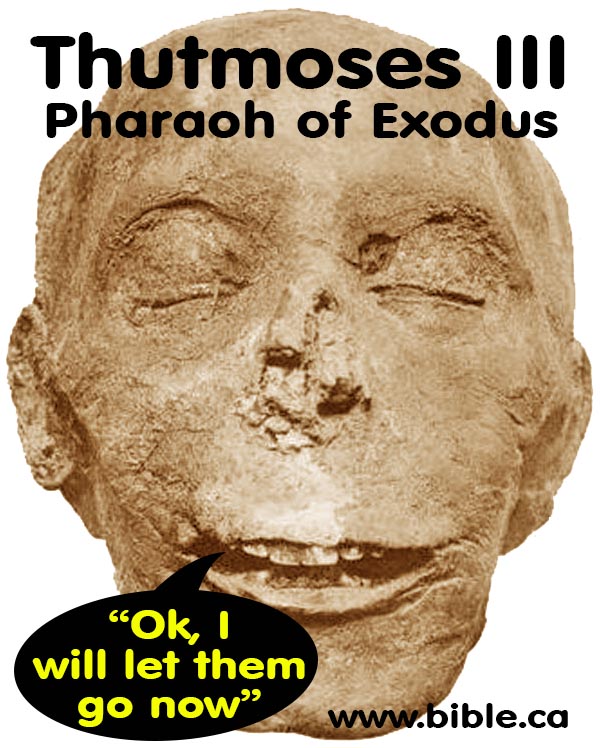
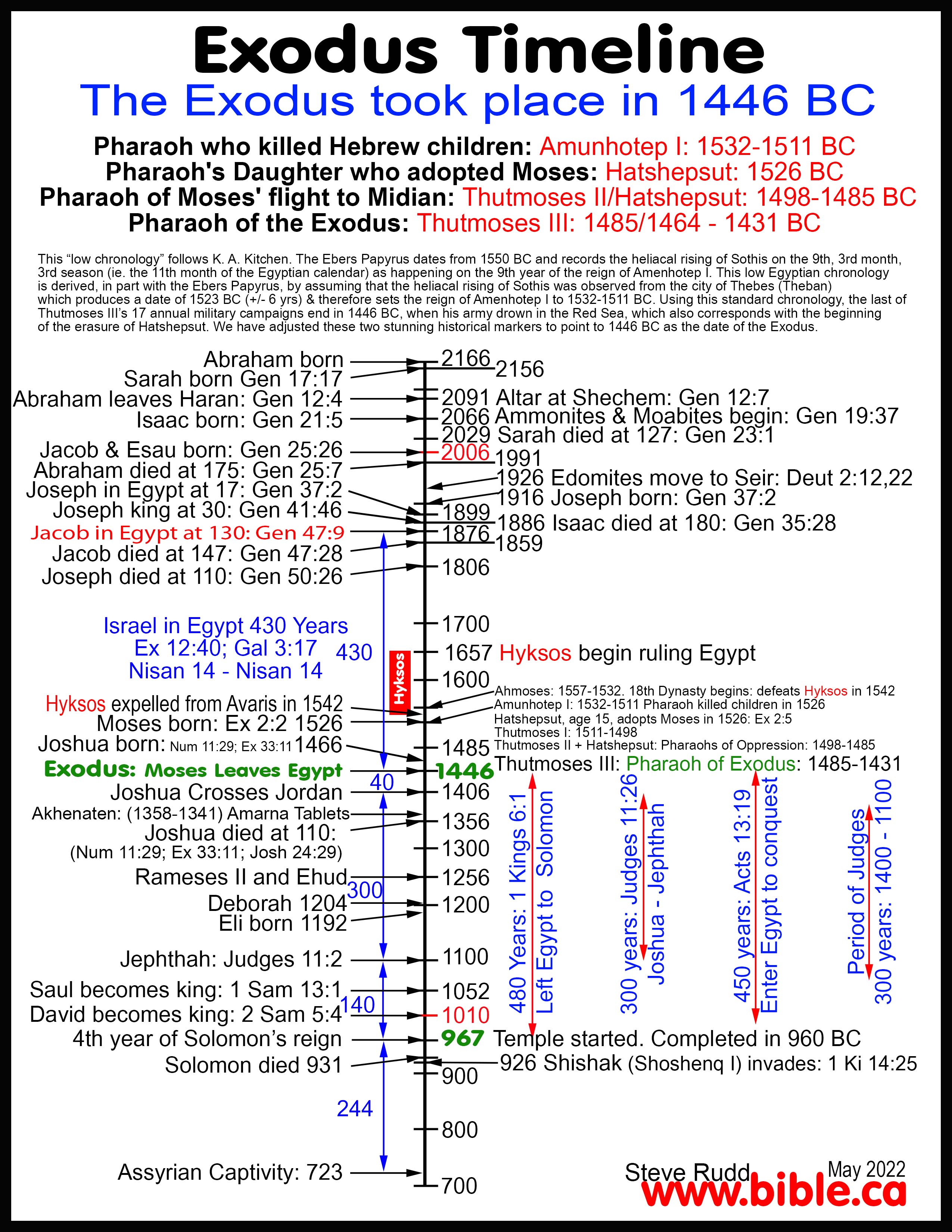
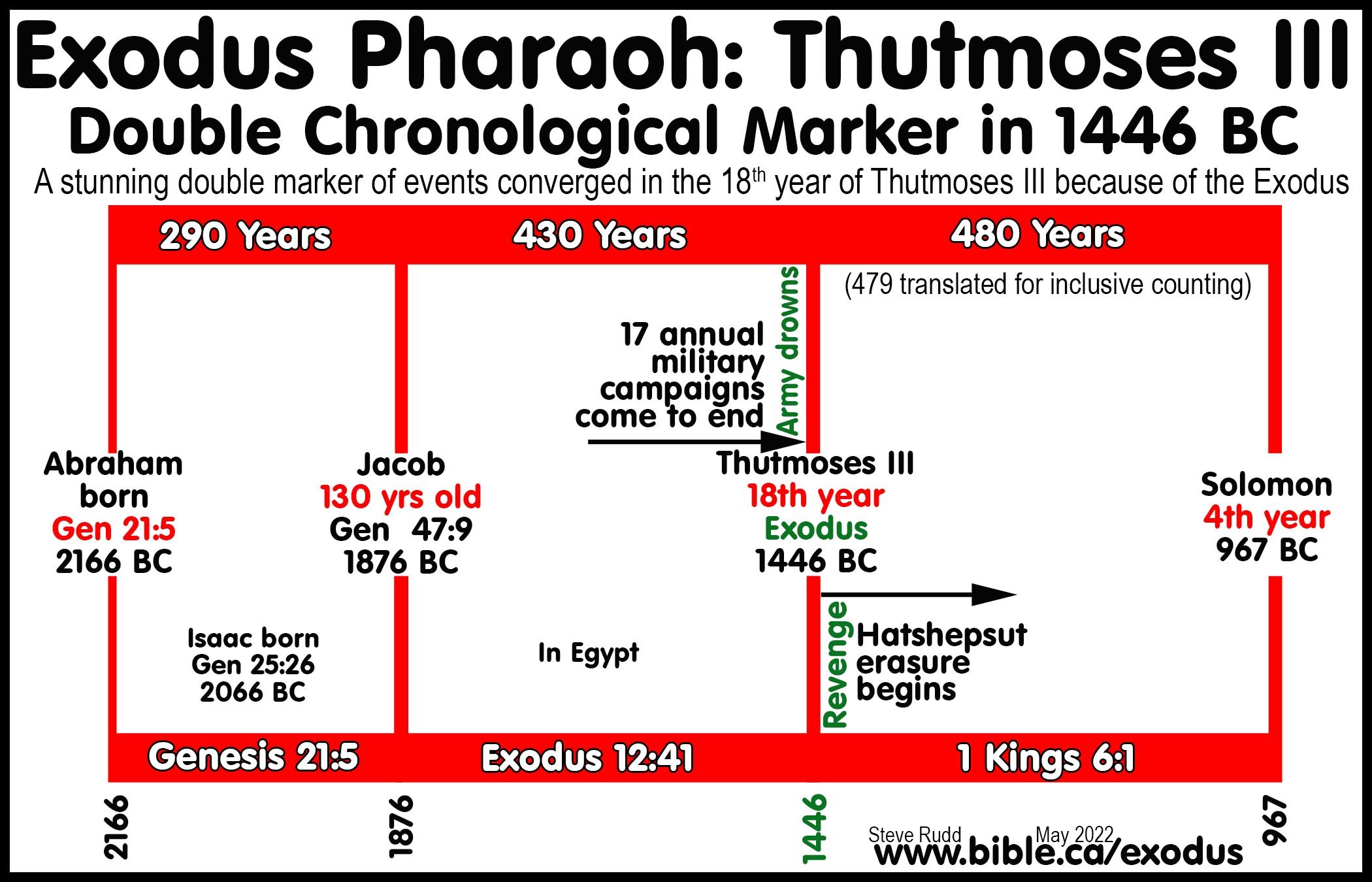
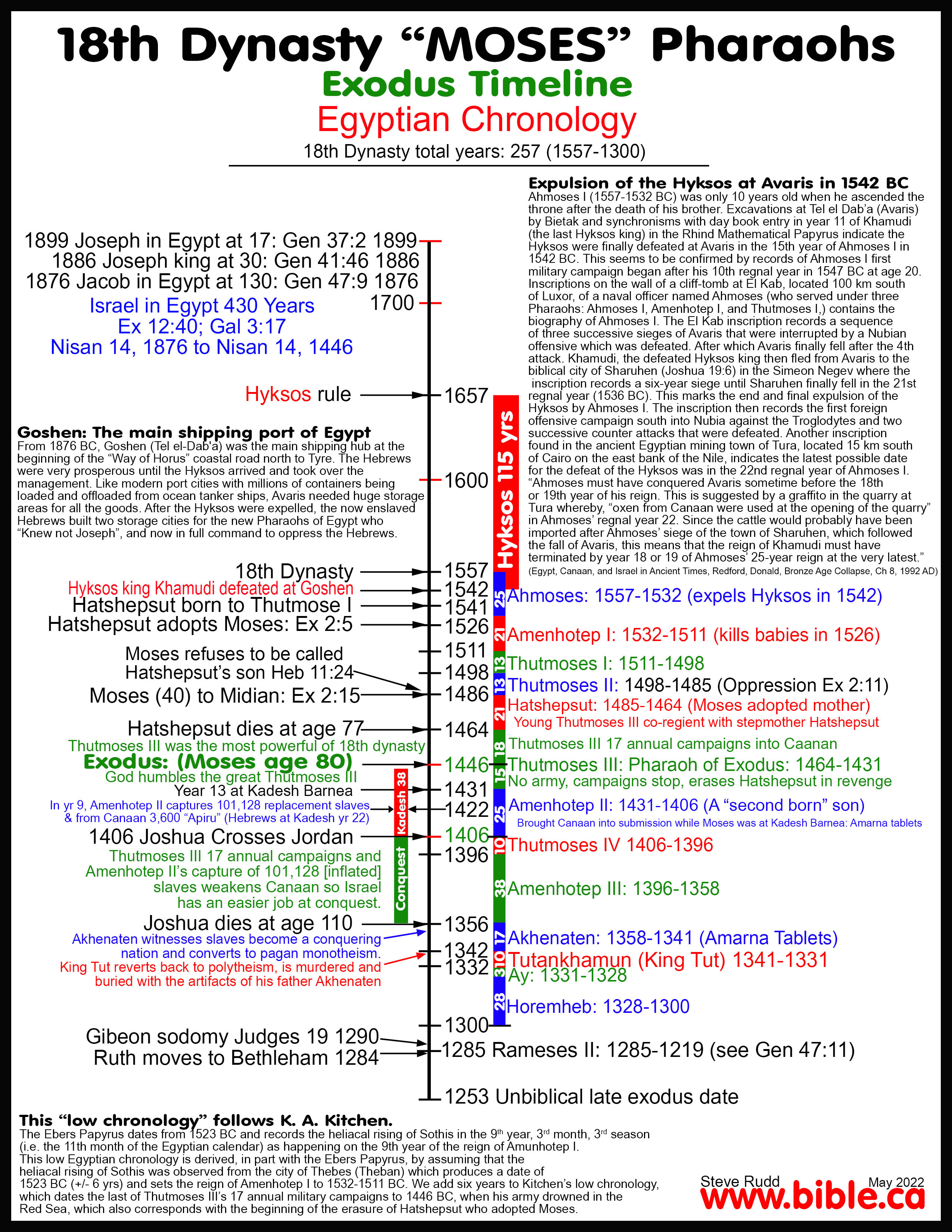
Fascinating, thanks.
ReplyDelete